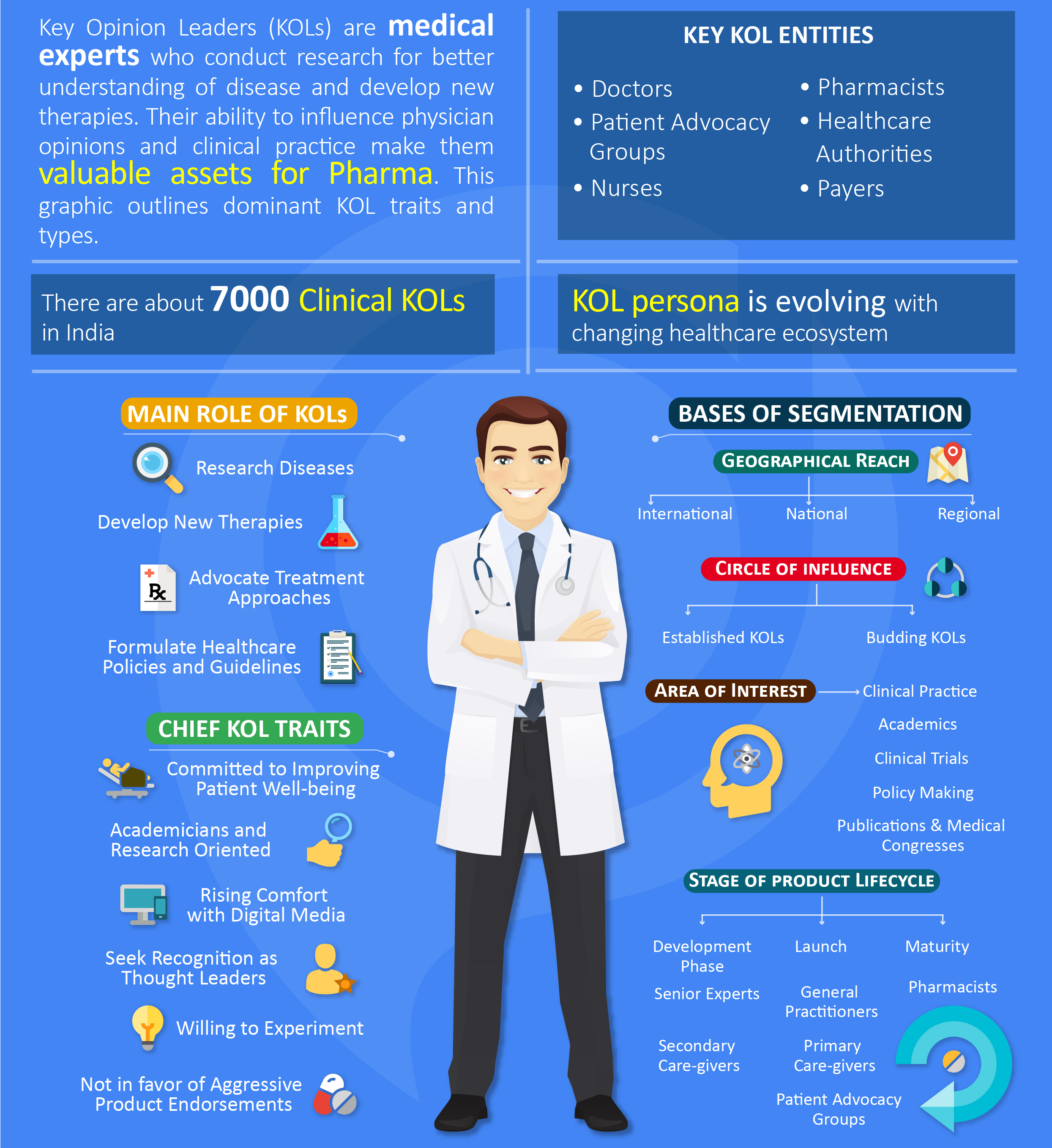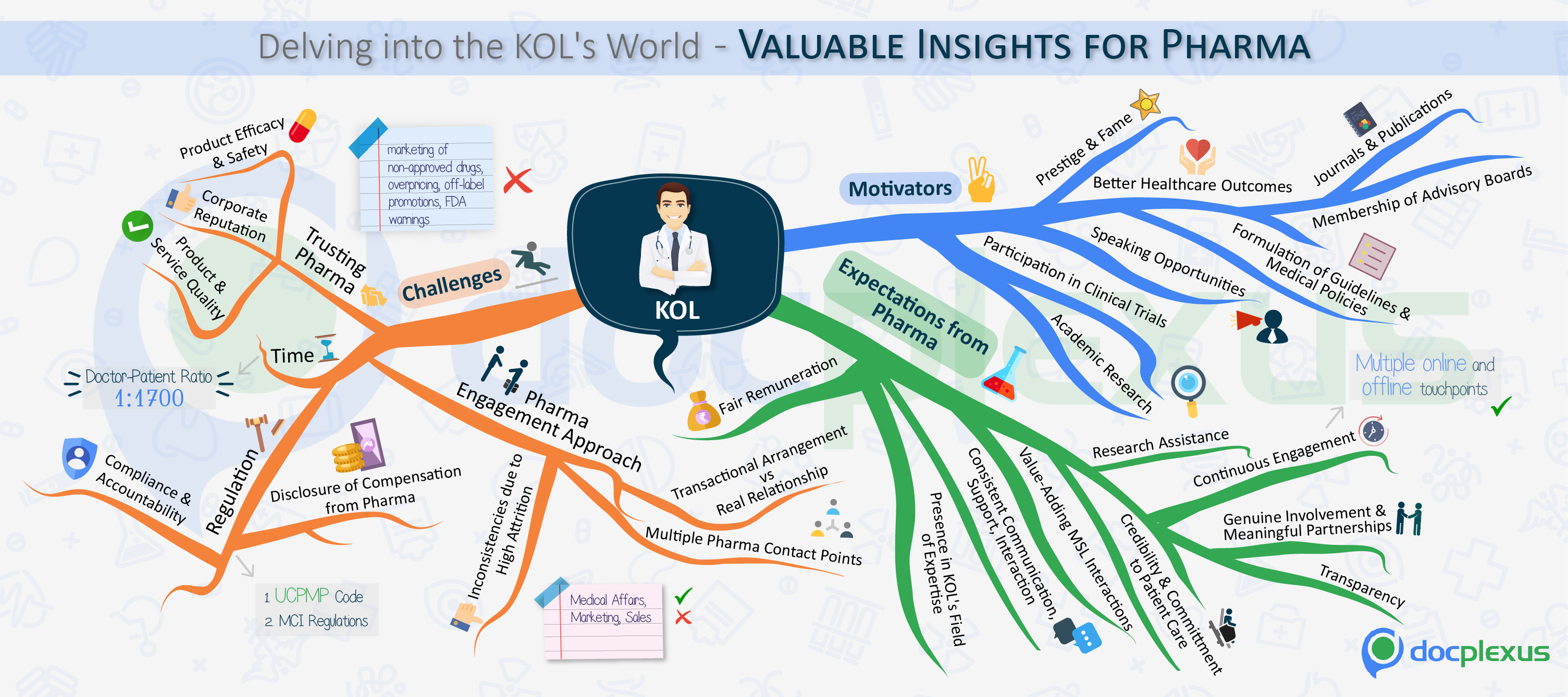
Pharma companies heavily rely on Key Opinion Leaders (KOLs) for creating drug awareness and lending credibility to their products in the minds of the medical community. Having had firsthand experience with how medical treatments impact patient outcomes, KOLs are uniquely placed to provide accurate feedback on the real-world effects of Pharma’s offerings and help develop the most suitable drugs. As medical science becomes more complex, regulations become more stringent, and demand for niche products and personalized treatments grows, KOLs are set to play an even more important role at each stage of the drug’s lifecycle in the years to come.
However, getting the most respected thought leaders on board and leveraging them optimally is easier said than done. Amidst COVID-19, the dynamics of KOL engagement have changed. You can read about that here.
An ever-evolving healthcare landscape coupled with pharma’s strategic myopia and ineptitude at decoding the KOL mindset has resulted in the inefficient management of these valuable assets.
Pharma must adopt a comprehensive KOL engagement strategy that places KOLs at the center and commit to fulfilling their needs. For this to happen, pharma needs to gain an in-depth understanding of KOL traits and types, their motivators, challenges, and expectations.
Decoding KOLs

Being highly reputed in their field of medical expertise, KOLs act as strong independent voice that is committed to improving patient health. Their understanding of what treatments will benefit patients the most makes them a valuable resource to pharma right from research to market access. Although KOLs are generally perceived to be expert medical practitioners, the term has evolved to include nonclinical entities that influence prescriptions, namely, healthcare authorities, nurses, patient advocacy groups, pharmacists, etc. Today’s KOLs are more open to experimenting with new media. Several of them are active on digital networking platforms and have an extended circle of influence that crosses geographical borders.
KOL Mind Map – Motivators, Challenges, and Expectations

Click to View the Enlarged Mind Map
The KOL world is stiffly competitive and staying ahead of the curve is a formidable task. KOLs value early access to path-breaking therapies through associations with pharma and hope the partnerships to ultimately lead to better medical outcomes. Many look forward to speaking opportunities in which they can provide insights into effective treatment approaches and boost their reputation as experts. Awards, memberships in prestigious societies, and international associations are also of high value to them. However, KOLs are not inclined to actively endorse pharma products. They lack trust in information provided by pharma and fear losing their reputation by associating with the wrong companies. A majority consider maintaining relations with more than one pharma partner, a delicate affair. It is common for them to conduct due diligence before partnering with a company and a key factor influencing this decision is the already existing partnerships of the company with other KOLs.
Key Success Factors of Effective KOL Engagement
Nail KOL Profiling – Identification and mapping of KOLs is the first step toward engaging KOLs effectively. KOLs’ interests range from clinical trials and membership of advisory boards to speaker programs and academic publications. Apart from professional inclinations, their personality traits, popularity, connectedness, hobbies, beliefs, and values should also be analyzed for better fitment with pharma’s priorities and objectives. ‘KOL Value‘ is a complex interplay of a multitude of factors such as career summary, qualification, press coverage, awards and honors, publications, memberships in societies, etc. For instance, although the number of publications of a KOL is a key criterion, it is even more important to know the exact nature of contribution to that publication. Also, while a KOL may not have exceptional influential power, he/she may be a ‘Bridge Builder’ by virtue of maintaining key connections to influential thought leaders.
Traditional methods of KOL identification and mapping such as observations, surveys, and literature searches have several limitations such as skewed results, biases, excessive time consumption, and limited reach. Research has revealed that bibliometric methods cannot identify over 50% of KOLs as compared to social network analysis. Social network analysis is not only scalable and free from responder bias but also provides rich contextual information and hidden insights into KOL’s position in a network. It also uncovers the presence of hidden physician clusters i.e. cohesive groups.
Plan for Full Product Lifecycle – Pharma must develop a clear and comprehensive KOL management plan considering typical KOL activities in every phase of the drug’s development and targeting the right type of KOLs for each phase. This will help it assess capability gaps for meeting objectives and take necessary measures to fill those gaps. A good strategy is to nurture a core group of KOLs who act as ‘anchor points’ while engaging with other KOLs depending on specific requirements of therapeutic areas. The drug approval phase requires KOLs who are experts in regulatory matters and can make effective arguments in favor of clinical results and the product to patients and payers. Post approval of the product, the need shifts to making presentations at congresses and symposia, publishing articles and papers, and participating in medical education programs. While doing all of this, pharma should not forget to stay aligned with KOL’s needs and goals. It must also make rational predictions about future changes in the healthcare landscape and their impact on organizational requirements and incorporate these into its KOL management plan.
Move Away from Transactional Mindset – KOLs thrive on being recognized for their valuable contribution to creating path-breaking medicines. They expect to be treated as equals by pharma companies in the quest for better healthcare outcomes. It is high time Pharma lets go of its fee-for-service approach and gives KOLs the respect they deserve by seeking genuine collaboration with the KOL community. KOLs should not be pushed to promote products. Rather than focusing on how they can boost its top line, pharma should help them achieve its specific goals. A long-term partnership in which both entities understand the purpose of collaboration and agree to commit their share of resources so that respective commitments are fulfilled on time is needed. An organization-wide KOL strategy will ensure efficient KOL engagement and minimize compliance issues. The best approach is to assign a KOL customer manager as a single-point contact so that the same KOL is not approached by multiple pharma representatives (e.g. medical affairs, sales team, marketing team, etc.).
Build the Best Medical Affairs Team – The world of big data, niche drugs, and specialized therapies has changed KOLs’ needs from pharma. Communication of complex science behind new-age drugs requires the expertise of Medical Affairs personnel. Medical Science Liaisons are capable of having in-depth discussions on the drug design, the targeted pathways, its mode of action, and much more, with KOLs, which can help pharma engage with physicians right from the early stages of the drug development. Therefore, pharma companies should invest in developing the competencies of the MSL team by equipping them with superior communication skills, digital knowledge, and a comprehensive understanding of the market situation. Essential competencies for MSLs include analytical thinking, persuasiveness, scientific, regulatory, and presentation expertise, customer focus, communication clarity, responsiveness, and solutions orientation. Senior employees like Chief Medical Officers should be given ownership of KOL management. Also, pharma should employ technologies using which MSLs can measure the impact of their engagement and better manage their relationship with KOLs. Pharma must maintain the firewall between the medical affairs and marketing/commercial functions and not ask MSLs to operate as a ‘sales force in disguise’. (More on Why MSLs are the Rising Stars of Pharma Communications)
Maintain Continuous Engagement Across Channels – High market fragmentation has created stiff competition among pharma marketers to bring on board the most influential KOLs for their therapeutic area. Given this situation, those marketers who maintain a constant connection have higher chances of grabbing KOL’s attention. Moreover, a new type of KOLs, the ‘Digital KOLs’ has emerged in recent times. These doctors have a strong digital presence and prefer a combination of online channels to have frequent interactions with peers. In such cases, any new medical update gets communicated and discussed in doctor networks almost instantly. Pharma must ensure that they provide KOLs with all the available avenues to engage in a meaningful dialogue with their community. It is extremely important to continue communicating with even those KOLs that remain unconvinced or unwilling to associate with the company.
Ensure Complete Transparency – Pharma’s practice of playing down or concealing the drug’s adverse effects to boost prescription rates has cost it its reputation in the public eye and the trust of the KOL community. KOLs find it tough to associate with companies that appear to not have patients’ best interests at heart. Currently, there is a widespread clamor for complete information on clinical trial results from all healthcare stakeholders including KOLs, across the world. Indian generic manufacturers are already bearing the brunt of poor quality standards in the form of warnings from the USFDA. The government of India is on the verge of bringing in its own version of the Sunshine Act by legalizing the UCPMP code. It is high time Indian pharma makes transparency and full disclosure a priority. Only then will it regain lost trust and secure long-term association with KOLs.
Offer Fair Remuneration – KOL Compensation is another key area in which transparency and compliance are lacking. KOLs often have to deal with inconsistencies or disparities in honorariums offered by pharma companies. The absence of an objective tiering model, compensation benchmarks, and auditing & compliance records are some of the challenges in this area. Moreover, there is no clarity on the criteria as well as the range of premium payments. Pharma should adopt the Fair Market Value (FMV) Model of Compensation which is based on effective tiering criteria and objective data analysis. Some best practices include offering higher fees for higher expertise, shorter negotiation cycles, and standardized FMV rate cards.
Seek Relevant Feedback and Monitor Key Metrics – To reinforce its commitment to genuine collaboration with KOLs, pharma must regularly seek their feedback at every stage of the product lifecycle, incorporate it for better drug development, and communicate the same to them. It should also ask KOLs to evaluate its engagement practices to align with their expectations. However, KOLs may not be forthcoming in objective evaluation of MSLs or other representatives with whom they interact regularly. Therefore, pharma should opt for digital surveys and opinion polls conducted 3rd parties which can present a true picture of current KOL engagement practices. It should also track parameters like KOL retention, the scope of association, peer endorsements, market access, etc.
To conclude, effective KOL engagement is indispensable to pharma’s success in today’s dynamic healthcare environment. A strategy that leads to a Win-Win Situation for both parties and ultimately benefits patient well-being would prove to be the best solution.
Docplexus has engaged with several eminent KOLs belonging to various specialties. Their knowledgeable discourses add great value to our members’ clinical practice. (Access Docplexus KOL Interviews and Webinars)
Suggested reading – Changing dynamics of KOL engagement during COVID-19
